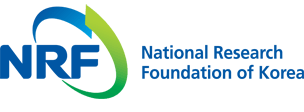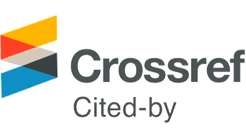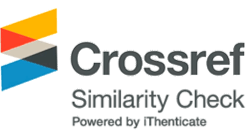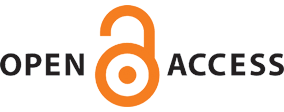-
Article
-
A Study of Designing Networks for Urban Air Mobility in Seoul Metropolitan Area
한국형 도심항공교통(K-UAM) 수도권 네트워크 구축에 관한 연구
-
JEONG, Inhoe, SON, Bongsoo
정인회, 손봉수
- Korean Urban Air Mobility (K-UAM) plans to be implemented in three phases according to the technology roadmap: the Introduction Phase (starting from …
한국형 도심항공교통(K-UAM)은 정부 기술로드맵에 따라 도입기(2025~), 성장기(2030∼), 성숙기(2035 이후) 등 3단계로 구분하여 추진할 계획이다. 도입기에는 서울시, 인천시, 경기도 등 수도권 내 4개 …
- Korean Urban Air Mobility (K-UAM) plans to be implemented in three phases according to the technology roadmap: the Introduction Phase (starting from 2025), the Growth Phase (2030 and onwards), and the Maturity Phase (after 2035). During the Introduction Phase, a total of 4 vertiports will be established in the Seoul metropolitan area, including Seoul, Incheon, and Gyeonggi Province. In the Growth Phase, additional 4 vertiports will be added, and in the Maturity Phase, 12 more will be established, totaling 20 vertiports. The objective of this paper is to develop a K-UAM network for the Seoul metropolitan area across these three phases. The locations for vertiports (including vertihubs) were selected considering the physical constraints such as the UAM aircraft’s turnaround process, FATO, TLOF, potential user demand, and the need to promote balanced development across the metropolitan area. According to the study, the 20 vertiports are distributed as follows: 7 in Seoul, 2 in Incheon, and 11 in Gyeonggi Province. The study assessed the appropriateness of the proposed network. To this end, a survey was conducted with 110 experts in the UAM field, and secondly, the number of routes proposed in the K-UAM technology roadmap was compared. Survey results indicate that, regarding the validity of vertiport (including vertihub) selection and the reasonableness of site selection criteria, the average response on a 5-point Likert scale was above 4. The average Likert scale value for the vertiport locations was above 3.7. Additionally, the number of operational routes in the phased network proposed in this study closely aligns with the results presented in the K-UAM technology roadmap. Based on these findings, the phased network proposed in this study for the Seoul metropolitan area is considered highly appropriate.
- COLLAPSE
한국형 도심항공교통(K-UAM)은 정부 기술로드맵에 따라 도입기(2025~), 성장기(2030∼), 성숙기(2035 이후) 등 3단계로 구분하여 추진할 계획이다. 도입기에는 서울시, 인천시, 경기도 등 수도권 내 4개 지점, 성장기에 4개 지점, 그리고 성숙기에 12개 지점 등 총 20개 버티포트를 구축한다. 본 논문의 목적은 K-UAM 수도권 3단계 네트워크를 구성하고, 그 적정성을 평가하는 것이다. 버티포트(버티허브 포함) 입지는 UAM 기체의 Turnaround process, FATO, TLOF 등 버티포트의 물리적 제약, 잠재적 이용수요, 및 수도권의 균형적인 발전 유도 등을 감안하여 선정하였다. 연구 결과에 따르면, 전체 20개 버티포트는 행정 구역별로 서울시 7개, 인천시 2개, 경기도 내 11개 지점이 선정되었다. 경기도 북부지역은 비행금지구역에 따른 제약으로 지점 선정에서 배제되었다. 본 연구는 제시한 네트워크의 적정성을 진단하였는데, 이를 위해, 첫째, 국내 UAM 전문가 110명을 대상으로 설문조사를 시행하였고, 둘째, K-UAM 정부 기술로드맵에서 제시한 단계별 노선 수와의 비교 검증을 실시하였다. 전문가 설문조사 결과를 살펴보면, 버티포트(버티허브 포함) 선정의 타당성과 입지 선정기준의 합리성에 관해서, 리커트 5점 척도에서, 전체 응답자의 평균값은 4점 이상으로 나타났다. 버티포트 지점에 대해서는 전체 응답자의 리커트 척도 평균값은 3.7점 이상으로 나타났다. 또한, 본 연구에서 구성한 단계별 네트워크의 운항 노선수는 K-UAM 기술로드맵에서 제시한 결과와 매우 유사함을 확인하였다. 이러한 사실에 근거하여, 본 연구에서 구성한 UAM 수도권 3단계별 네트워크는 매우 적절한 것으로 판단된다.
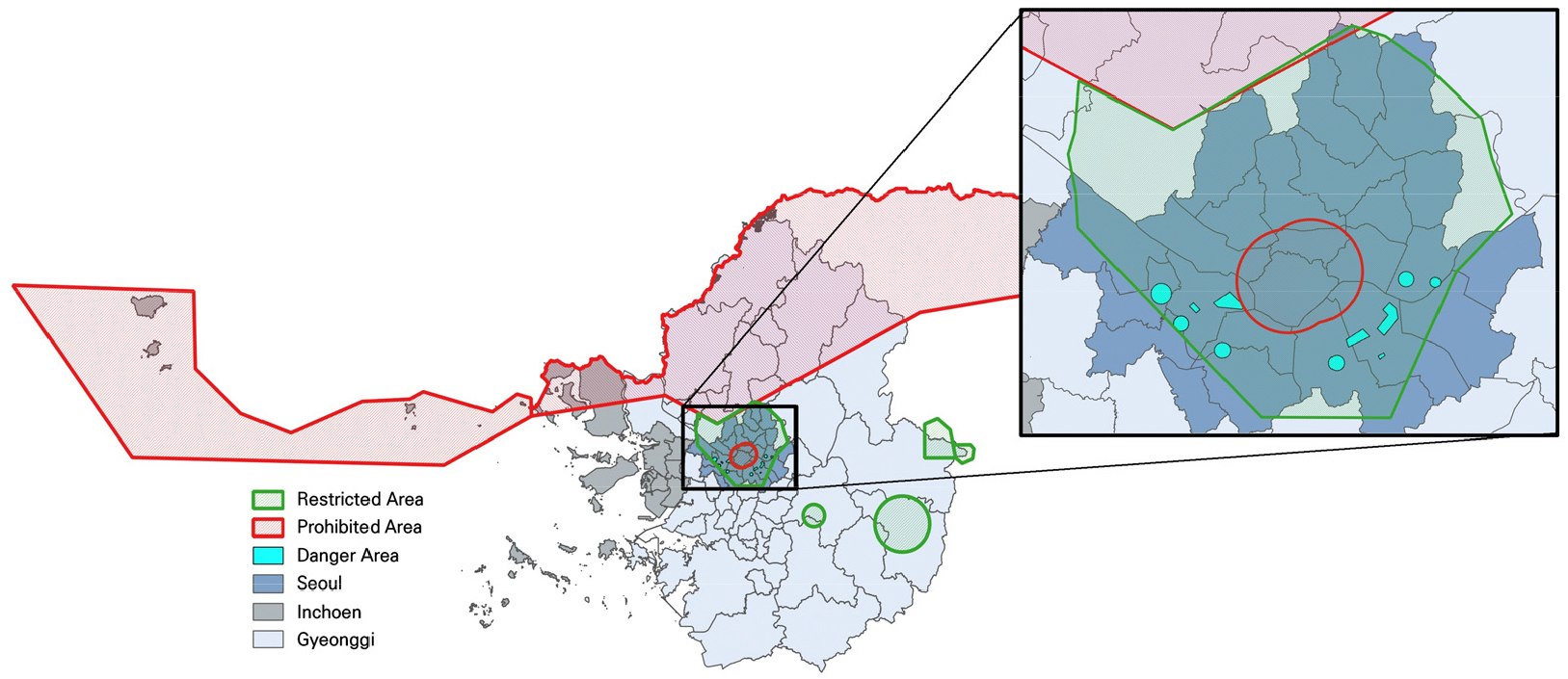
-
A Study of Designing Networks for Urban Air Mobility in Seoul Metropolitan Area
-
Article
-
Priority Section Selection and Quantitative Evaluation Indicator Development for the Undergrounding of Aboveground Railways in Seoul
서울시 지상철도 지하화 우선구간 선정과 정량적 평가 지표 개발
-
JANG, Jae Min, LEE, Sangkeun, KIM, Young Eun
장재민, 이상근, 김영은
- In 2024, the Korean government enacted the Special Act on Railway Undergrounding and Integrated Development of Railway Sites to address spatial fragmentation …
정부는 지상철도로 인한 도시공간의 단절과 주변 지역의 낙후 문제를 해결하고자, 2024년 「철도지하화 및 철도부지 통합개발에 관한 특별법」을 제정하였다. 본 연구는 이러한 제도적 …
- In 2024, the Korean government enacted the Special Act on Railway Undergrounding and Integrated Development of Railway Sites to address spatial fragmentation and deterioration of surrounding areas caused by above-ground railways. This study takes this institutional shift as an opportunity to identify priority sections for railway undergrounding among seven above- ground railway lines in Seoul and to propose strategic development directions. In particular, by establishing a structured quantitative evaluation framework that incorporates key elements—redevelopment needs, public benefit, and development feasibility—this study seeks to overcome the limitations of prior case-specific evaluations. The analysis is based on three criteria: (1) redevelopment needs and suitability, (2) public benefit, and (3) development feasibility and implementability, and utilizes spatial indicators such as floor area ratio, building age, land price, land ownership structure, and infrastructure conditions. Results show that the Gyeongui–Jungang Line, with a high proportion of underdeveloped areas, aging buildings, and public land, is a strong candidate for leading projects that can leverage both policy intervention and private investment. In contrast, the Gyeongwon Line demonstrates strong public demand but relatively low feasibility compared to surrounding lines, indicating a need for strategic intervention to enhance its development value. This study contributes by presenting a comparative, quantitative evaluation framework that supports decision-making for railway undergrounding projects and offers practical guidance for strategies that balance public benefit and profitability.
- COLLAPSE
정부는 지상철도로 인한 도시공간의 단절과 주변 지역의 낙후 문제를 해결하고자, 2024년 「철도지하화 및 철도부지 통합개발에 관한 특별법」을 제정하였다. 본 연구는 이러한 제도적 전환을 계기로, 서울시 내 7개 지상철도 노선을 대상으로 지하화 우선 추진 구간을 도출하고, 전략적 개발 방향을 제안하고자 하였다. 특히 정비 수요, 공공성, 사업성 등 핵심 요소를 반영한 정량 비교 분석틀을 체계화함으로써, 그간 사례별 개별 검토에 머물렀던 기존 평가 방식의 한계를 보완하고자 하였다. 분석은 ‘정비 수요와 개발 적합성’, ‘공공성’, ‘사업성 및 개발 용이성’의 세 가지 항목을 기준으로, 용적률, 건축물 노후도, 토지가격, 토지소유 구조, 기반시설 등 공간 지표를 활용하여 수행되었다. 분석 결과, 경의중앙선은 저개발 구간 비율과 노후 건축물 비중이 높고 국공유지 비율도 높은 것으로 나타나, 정책 개입과 민간 유인을 동시에 유도할 수 있는 선도사업 후보지로 평가되었다. 반면, 경원선은 공공적 수요는 크지만 주변부에 비해 상대적으로 사업성이 낮아, 인접 노선 대비 개발 가치를 향상시킬 수 있는 전략적 개입이 요구되는 구간으로 분석되었다. 본 연구는 노선 간 상대 비교를 통한 정량 기반의 의사결정 지원 체계를 제안함으로써, 철도지하화 사업의 실행 가능성 진단과 함께 공공성과 수익성을 동시에 고려한 전략 수립에 실질적인 기초자료를 제공한다는 점에서 의의를 갖는다.
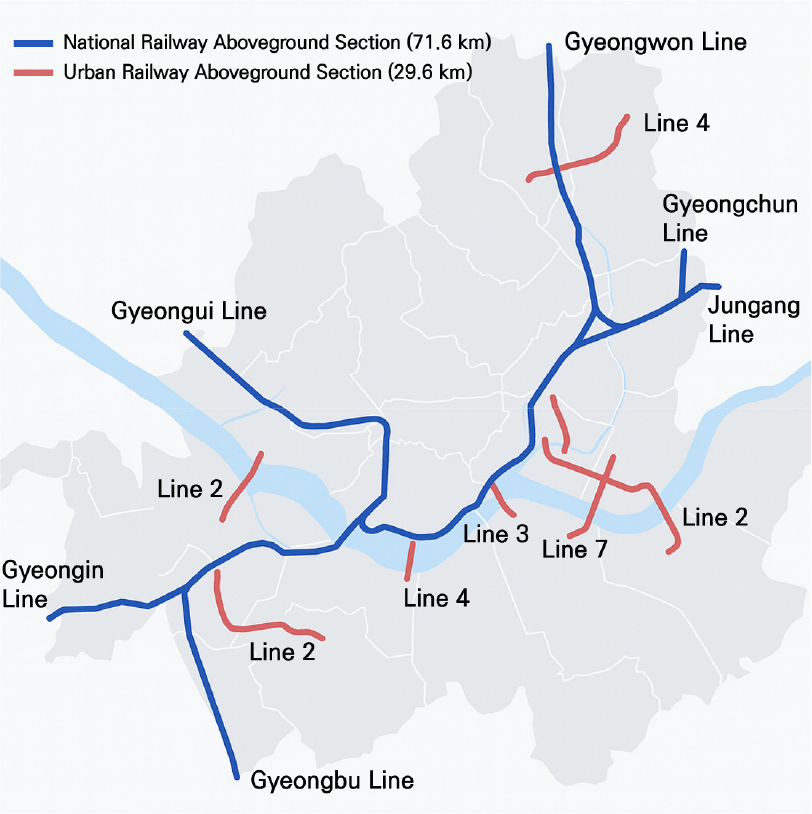
-
Priority Section Selection and Quantitative Evaluation Indicator Development for the Undergrounding of Aboveground Railways in Seoul
-
Article
-
Development of Autonomous Vehicle Edge Case Scenarios Based on Topic Modelling Through Dashcam Video Analysis : Focusing on Pedestrian, Motorcycle, Bicycle, E-Scooters
블랙박스 영상 분석을 통한 토픽모델링 기반의 자율주행차 Edge Case 시나리오 구축 : 보행자, 이륜차, 자전거, 전동킥보드를 중심으로
-
KIM, Taejun, CHU, Hyeyeon, JANG, Jeong Ah, YUN, Hyunjeong, KIM, Junghwa
김태준, 주혜연, 장정아, 윤현정, 김정화
- Ensuring that autonomous vehicles can safely operate in complex road environments where they interact with various road users-including pedestrians, motorcycles, bicycles, and …
자율주행차가 다양한 도로 사용자와 혼재된 복잡한 도로 환경에서 안전하게 운행할 수 있도록 하는 것은 자율주행 기술 상용화를 위한 핵심 과제로 대두되고 있다. …
- Ensuring that autonomous vehicles can safely operate in complex road environments where they interact with various road users-including pedestrians, motorcycles, bicycles, and e-scooters-remains a critical challenge for the commercialization of autonomous driving technology. In particular, Edge Case scenarios, which are characterized by their low occurrence probability but high risk, are essential for validating the safety and reliability of autonomous vehicles. However, existing research has primarily focused on safety evaluation scenarios involving interactions between autonomous and conventional vehicles, with limited consideration of diverse road users such as pedestrians, motorcycles, bicycles, and scooters in real-world traffic environments. This study aims to develop Edge Case scenarios that address potential accident risks faced by autonomous vehicles. To achieve this, 2,410 dashcam dataset were collected from the youtube channel ‘HanMoonchul TV’. The data were processed through text preprocessing, topic modelling using the Latent Dirichlet Allocation (LDA) technique to extract key accident risk factors. The identified risk factors were classified according to the Pegasus 5-layer framework. Based on this classification, various Edge Case scenarios involving interactions with pedestrians, motorcycles, bicycles, and e-scooter were constructed. The results demonstrate that the designed scenarios enable autonomous vehicles to operate reliably even in unpredictable accident situations. These scenarios serve as tools for validating the safety and performance of autonomous vehicles. By employing a data-driven approach, this study addresses proposes a methodology for developing scenarios to evaluate safety in complex traffic environments.
- COLLAPSE
자율주행차가 다양한 도로 사용자와 혼재된 복잡한 도로 환경에서 안전하게 운행할 수 있도록 하는 것은 자율주행 기술 상용화를 위한 핵심 과제로 대두되고 있다. 특히, 발생 가능성은 낮지만 위험성이 높은 Edge Case 상황은 자율주행차의 안전성과 신뢰성을 검증하는 것이 매우 중요하다. 그러나 현재까지의 연구는 자율주행차와 차량 간 사고 중심의 안전성 평가 시나리오 구축에 집중되어 있으며, 실제 도로에서 자율주행차가 상호 작용할 보행자, 이륜차, 자전거, 킥보드 등의 다양한 객체를 고려한 연구는 부족한 실정이다. 이에 본 연구는 자율주행차와 해당 객체 간의 사고 위험상황을 다룰 수 있는 Edge Case 시나리오를 구축하는 것을 목표로 한다. 이를 위해, 유튜브 채널 '한문철 TV'에서 수집한 2,410건의 블랙박스 교통사고 데이터셋을 기반으로 LDA 토픽모델링 기법을 사용하여 주요 사고 위험 요인을 도출하였다. 도출된 위험 요인은 Pegasus 5-layer 포맷에 따라 체계적으로 분류하고, 이를 바탕으로 자율주행차와 보행자, 이륜차, 자전거, 전동킥보드 간 다양한 사고 시나리오를 구축하였다. 분석 결과, 자율주행차가 예측하기 어려운 사고 상황에서도 대응성을 향상할 수 있는 시나리오를 구축했으며, 이러한 시나리오는 실도로에서 자율주행차의 안전성과 성능 검증을 위한 도구로 활용될 수 있을 것으로 기대된다. 또한, 본 연구는 데이터 기반 접근 방식을 통해 복잡한 교통 환경에서 자율주행차의 안전성 평가를 위한 체계적인 시나리오 구축 방법을 제시하였다.
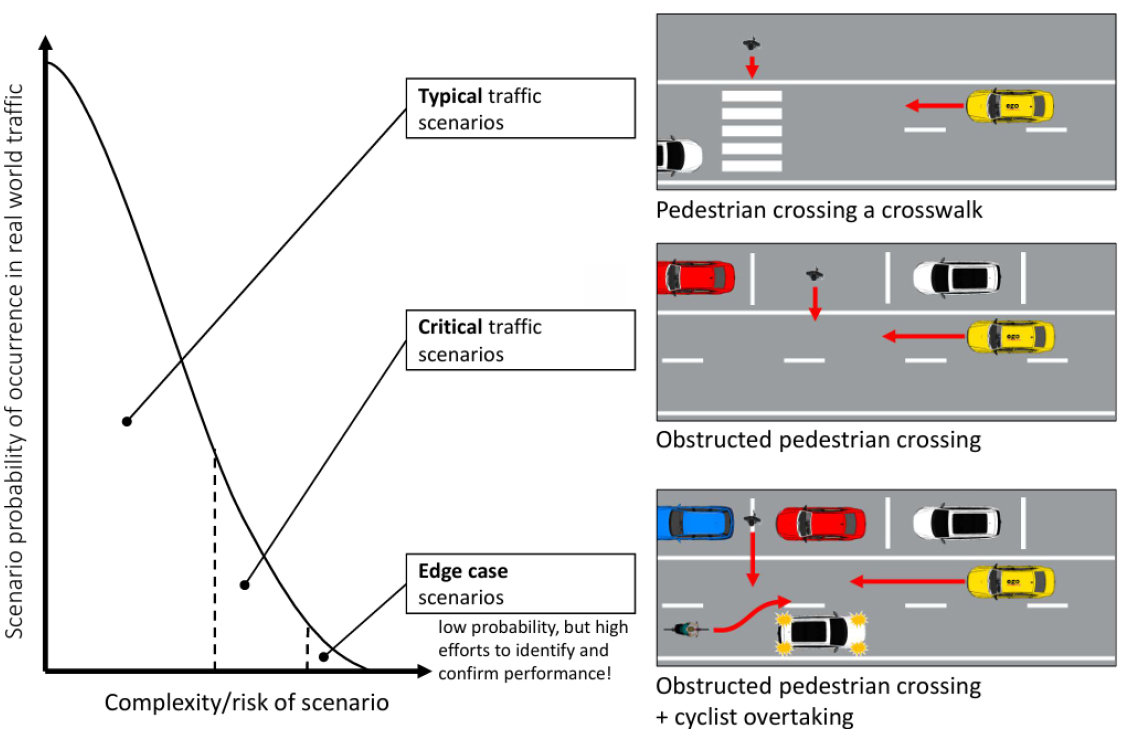
-
Development of Autonomous Vehicle Edge Case Scenarios Based on Topic Modelling Through Dashcam Video Analysis : Focusing on Pedestrian, Motorcycle, Bicycle, E-Scooters
-
Article
-
Development of a Methodology for Estimating Control Delay Based on Vehicle Occupancy using Video Detectors
영상 검지기를 활용한 차량 점유율 기반의 제어 지체 산출 방법론 개발
-
MOON, Seokmin, KIM, Junwon, HAN, Yohee, JEON, Jae Hyeon, KIM, Youngchan
문석민, 김준원, 한여희, 전재현, 김영찬
- Control delay at signalized intersections is a key indicator for evaluating operational performance, as it quantifies the time loss based on vehicle …
신호교차로의 제어 지체는 운영 상태를 평가하는 핵심 지표로, 차량의 진입 시점과 진출 시점에 따른 시간 손실을 정량화하여 교차로 운영 평가에 중요하게 작용한다. …
- Control delay at signalized intersections is a key indicator for evaluating operational performance, as it quantifies the time loss based on vehicle entry and exit times. Traditional control delay estimation methods often simplify vehicle arrival distributions, failing to fully reflect actual intersection conditions or relying on adjustment factors. To overcome these limitations, this study proposes a delay estimation methodology without arrival pattern adjustments by data collected from video detectors. The advancement of video recognition technology enables vehicle detection on signalized intersection approaches, providing information not only on passing traffic but also on the detection coverage within the approach area. Using video detectors, we collected per-second vehicle occupancy and throughput, and estimated the average control delay of intersection movements based on total travel time and free-flow travel time. Simulation results comparing the proposed methodology with conventional delay estimation methods indicate that our approach reduces delay estimation errors per cycle by more than 32%. This methodology more accurately reflects delay trends at signalized intersections, allowing for real-time analysis and contributing to traffic management utilizing video-based data.
- COLLAPSE
신호교차로의 제어 지체는 운영 상태를 평가하는 핵심 지표로, 차량의 진입 시점과 진출 시점에 따른 시간 손실을 정량화하여 교차로 운영 평가에 중요하게 작용한다. 기존의 제어 지체 산정 방법은 차량 도착 분포를 단순화하여 실제 교차로 상황을 충분히 반영하지 못하거나, 연동에 의한 보정 계수를 적용하여 보완한다. 본 연구에서는 이러한 한계를 극복하기 위하여, 영상 검지기로부터 수집된 정보를 바탕으로 차량 도착 형태에 대한 보정 과정이 불필요한 지체 산정 방법론을 제안하였다. 영상 인식 기술을 활용하여 신호교차로 접근로의 차량 검지가 가능해짐에 따라, 통과 교통량뿐만 아니라 접근로 내 영상 검지 범위에 대한 정보를 생성할 수 있게 되었다. 영상 검지기를 통해 매초 차량 점유율 및 통과 차량 수를 수집하였고, 총 통행시간과 자유통행시간을 통해 교차로 이동류의 평균 지체를 산출하였다. 시뮬레이션을 통해 제안된 방법론을 기존 지체 산정 방법과 비교한 결과, 본 방법론은 기존 방법 대비 주기 단위 지체 산정 오차를 32% 이상 감소시켰다. 본 연구의 방법론은 신호교차로 지체 추이를 보다 정확히 반영하여 실시간 분석에 활용할 수 있으며, 영상 데이터를 활용한 교통 관리에 기여할 수 있을 것으로 기대된다.
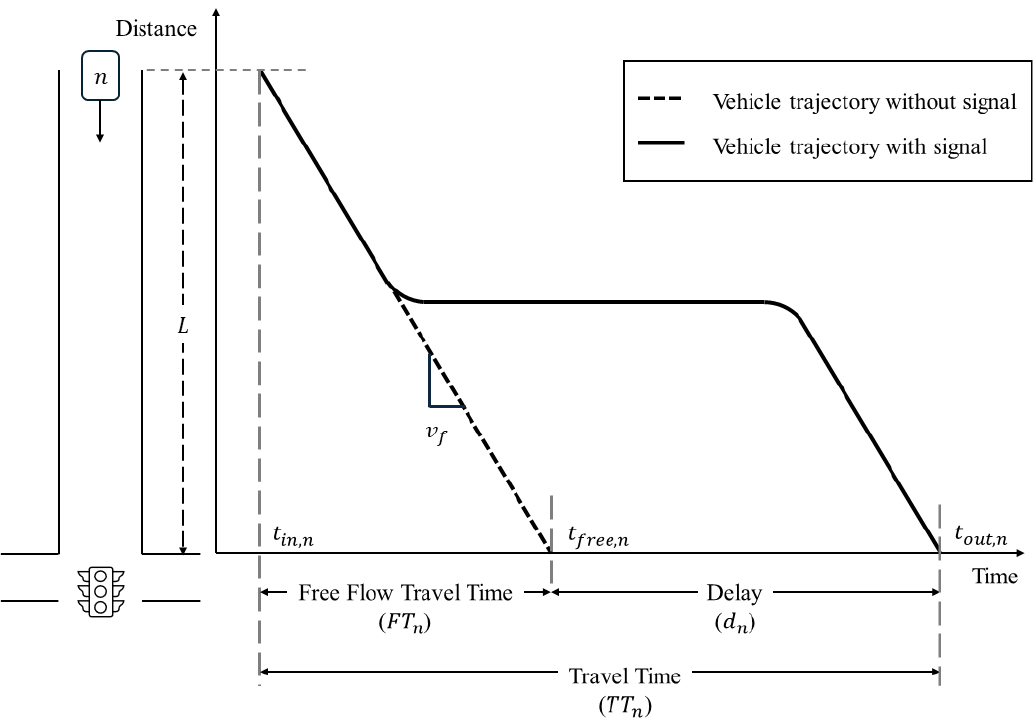
-
Development of a Methodology for Estimating Control Delay Based on Vehicle Occupancy using Video Detectors
-
Article
-
Spatial Structure of Travel Patterns and Network-Based Community Analysis of Specialized Transportation Services for Persons with Disabilities and General Automobile Users
장애인 특별교통수단과 일반 차량 이용자 통행 패턴의 공간적 구조 및 네트워크 기반 커뮤니티 분석
-
YU, Gahyeong, JANG, Jinhyeok, HWANG, Jinuk
유가형, 장진혁, 황진욱
- Understanding mobility patterns is essential for ensuring equitable urban and transportation planning, particularly for vulnerable populations such as people with disabilities. This …
본 연구는 일반 차량 이용자와 장애인 특별교통수단 이용자의 통행 패턴을 비교·분석하여, 두 집단 간 공간적 불균형과 통행 제약을 실증적으로 규명하는 것을 목적으로 …
- Understanding mobility patterns is essential for ensuring equitable urban and transportation planning, particularly for vulnerable populations such as people with disabilities. This study compares the travel patterns of general automobile and specialized transportation services for persons with disabilities in Busan, South Korea, focusing on spatial disparities and mobility constraints. Using origin-destination (OD) data, we analyze travel distribution patterns, spatial concentration, and network structures of both user groups. The Gini coefficient and entropy index were employed to measure spatial inequality and destination diversity of travel, revealing that specialized transportation service users exhibit significantly higher spatial concentration and lower destination diversity, compared to general automobile users. A hotspot analyses confirmed that general automobile trips are widely dispersed throughout the city, while specialized transportation trips are concentrated in specific districts with medical and welfare facilities. Additionally, community detection analyses showed that general automobile users form 21 distinct travel-based communities, reflecting decentralized and polycentric movement patterns, whereas specialized transportation users are grouped into only four large-scale communities, indicating constrained mobility and a strong reliance on specific destinations. These findings underscore the necessity of integrating diverse population groups’ travel patterns into urban and transportation planning. Policies should prioritize enhancing the accessibility of specialized transportation users by improving transit connectivity, expanding travel options, and ensuring equitable access to essential services.
- COLLAPSE
본 연구는 일반 차량 이용자와 장애인 특별교통수단 이용자의 통행 패턴을 비교·분석하여, 두 집단 간 공간적 불균형과 통행 제약을 실증적으로 규명하는 것을 목적으로 한다. 부산시를 대상으로 OD 데이터를 활용하여 통행 분포, 공간적 집중도, 네트워크 구조를 분석하였으며, 지니 계수와 엔트로피 지수를 이용하여 통행의 공간적 불평등성과 목적지 다양성을 평가하였다. 분석 결과, 장애인 특별교통수단 이용자는 일반 차량 이용자와 비교해 통행이 특정 지역에 집중되는 경향이 강하며, 목적지의 다양성 또한 낮은 것으로 나타났다. 핫스팟 분석 결과, 일반 차량 통행은 도시 전역에 분산된 반면, 장애인 특별교통수단 통행은 의료 및 복지시설이 밀집된 지역에 집중되는 경향이 확인되었다. 또한, 커뮤니티 디텍션 분석을 통해 일반 차량 이용자의 통행 기반 생활권은 21개로 도출되었으며, 다핵적인 구조를 형성하는 반면, 장애인 특별교통수단 이용자의 생활권은 4개로 집약되었으며 특정 목적지에 대한 의존성이 높게 나타났다. 이러한 결과는 장애인의 통행 특성을 고려한 교통 및 도시 계획의 필요성을 시사하며, 장애인 특별교통수단 이용자의 접근성 개선, 대중교통 연계 강화, 이동 선택지 확대를 위한 정책적 대응이 요구됨을 보여준다.
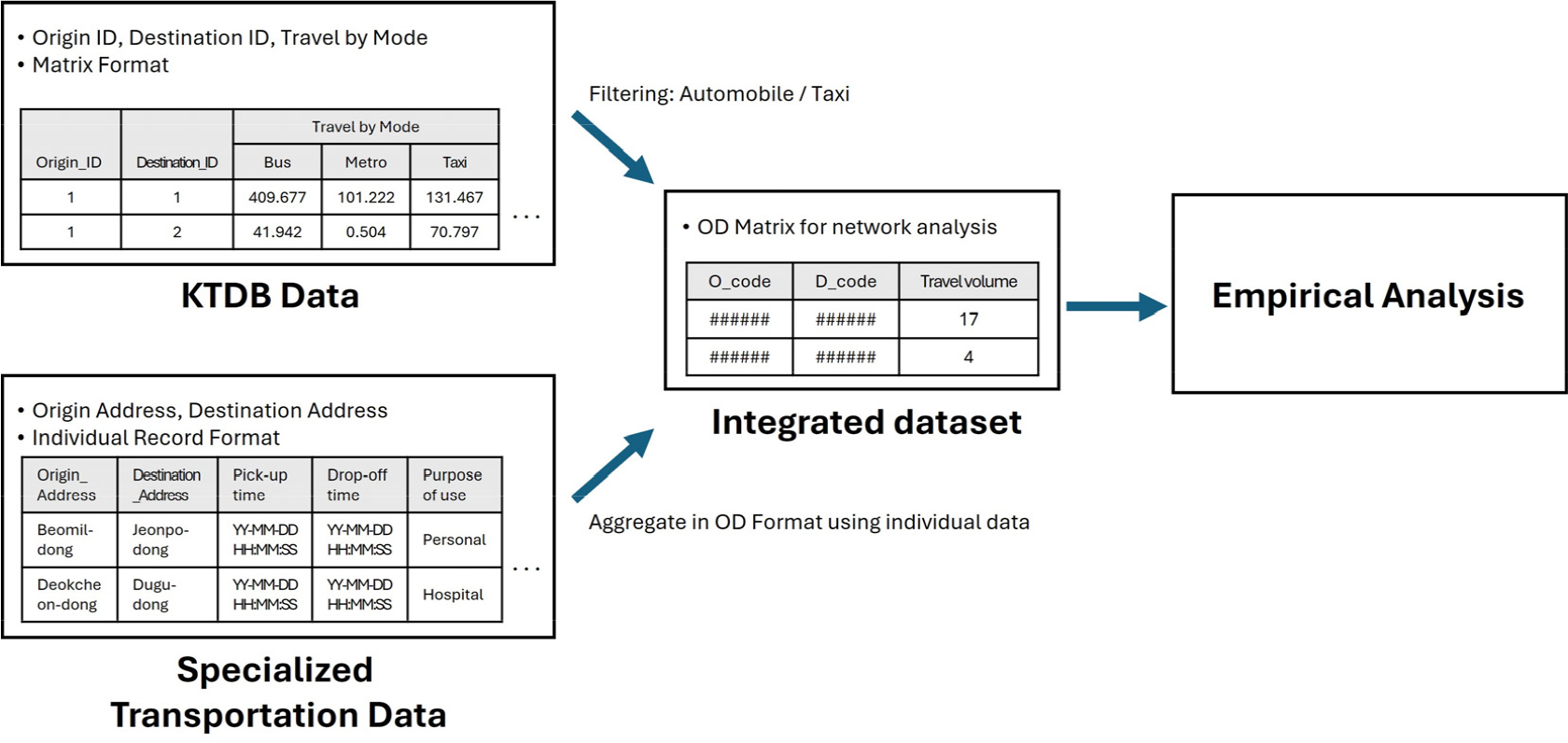
-
Spatial Structure of Travel Patterns and Network-Based Community Analysis of Specialized Transportation Services for Persons with Disabilities and General Automobile Users
-
Article
-
Network-Based Identification of Pedestrian Catchment Areas and Assessment of Public Service Accessibility and Equity: Focusing on Anchor Facilities in Busan Metropolitan City
네트워크 기반 보행생활권 도출과 공공서비스의 접근성 및 형평성 평가: 부산시 앵커시설을 중심으로
-
SUNG, Mingyu, JANG, Jinhyeok, HWANG, Jinuk
성민규, 장진혁, 황진욱
- This study presents a data-informed approach to delineate pedestrian catchment areas that better reflect actual pedestrian travel patterns. Pedestrian OD data from …
본 연구는 통행 OD 데이터를 기반으로 실제 보행 이동 흐름을 반영한 보행생활권을 도출하고, 생활권 간 공공서비스 접근성의 형평성을 분석하였다. 부산시를 대상으로 국가교통 …
- This study presents a data-informed approach to delineate pedestrian catchment areas that better reflect actual pedestrian travel patterns. Pedestrian OD data from the Korea Transport Database (KTDB) for Busan were preprocessed and refined using land use and topographic information. Based on the refined spatial units, functional pedestrian catchment areas were identified through community detection using the Louvain algorithm. GIS-based accessibility to key public facilities, referred to as “anchor facilities” by the Busan Metropolitan City Government (e.g., senior centers, children’s facilities, and sports facilities), was evaluated. In addition, equity in service coverage was assessed based on socioeconomic characteristics such as income level, proportion of elderly residents, and proportion of residents with disabilities. The analysis identified 44 pedestrian catchment areas exhibiting distinct network configurations. Significant disparities in service accessibility were found for senior and children’s facilities in low-income areas and in areas with higher proportions of residents with disabilities. This study proposes a data-informed method for defining pedestrian catchment areas based on actual travel patterns. The findings also provide foundational evidence to support pedestrian- oriented urban and transport planning and to guide the equitable allocation of public facilities.
- COLLAPSE
본 연구는 통행 OD 데이터를 기반으로 실제 보행 이동 흐름을 반영한 보행생활권을 도출하고, 생활권 간 공공서비스 접근성의 형평성을 분석하였다. 부산시를 대상으로 국가교통 DB(KTDB)의 보행 OD 데이터를 활용하였으며, 토지이용 및 지형 정보를 반영하여 공간 단위를 정제한 후, Louvain 알고리즘을 활용한 커뮤니티 디텍션 기법을 적용하여 기능적 보행생활권을 도출하였다. 이후 GIS 기반 분석을 통해 부산시에서 “앵커시설”로 분류한 주요 공공시설(노인시설, 어린이시설, 생활체육시설)에 대한 접근성을 평가하고, 각 보행생활권의 소득 수준, 고령 인구 비율, 장애인 인구 비율 등 사회경제적 특성에 따라 서비스 커버리지의 형평성을 분석하였다. 분석 결과, 총 44개의 보행생활권이 도출되었으며, 이들 간에는 공간적 구조와 접근성 측면에서 뚜렷한 차이를 보였다. 특히, 저소득층 및 장애인 인구 비율이 높은 지역에서 노인시설과 어린이시설에 대한 접근성이 통계적으로 유의미하게 낮게 나타났다. 본 연구는 행정경계에 의존하지 않고 실제 보행 흐름을 반영한 보행생활권 설정 방법을 제시하고, 보행 중심 도시·교통계획 및 공공서비스의 형평한 공간 분배를 위한 실증적 기초자료를 제공한다.
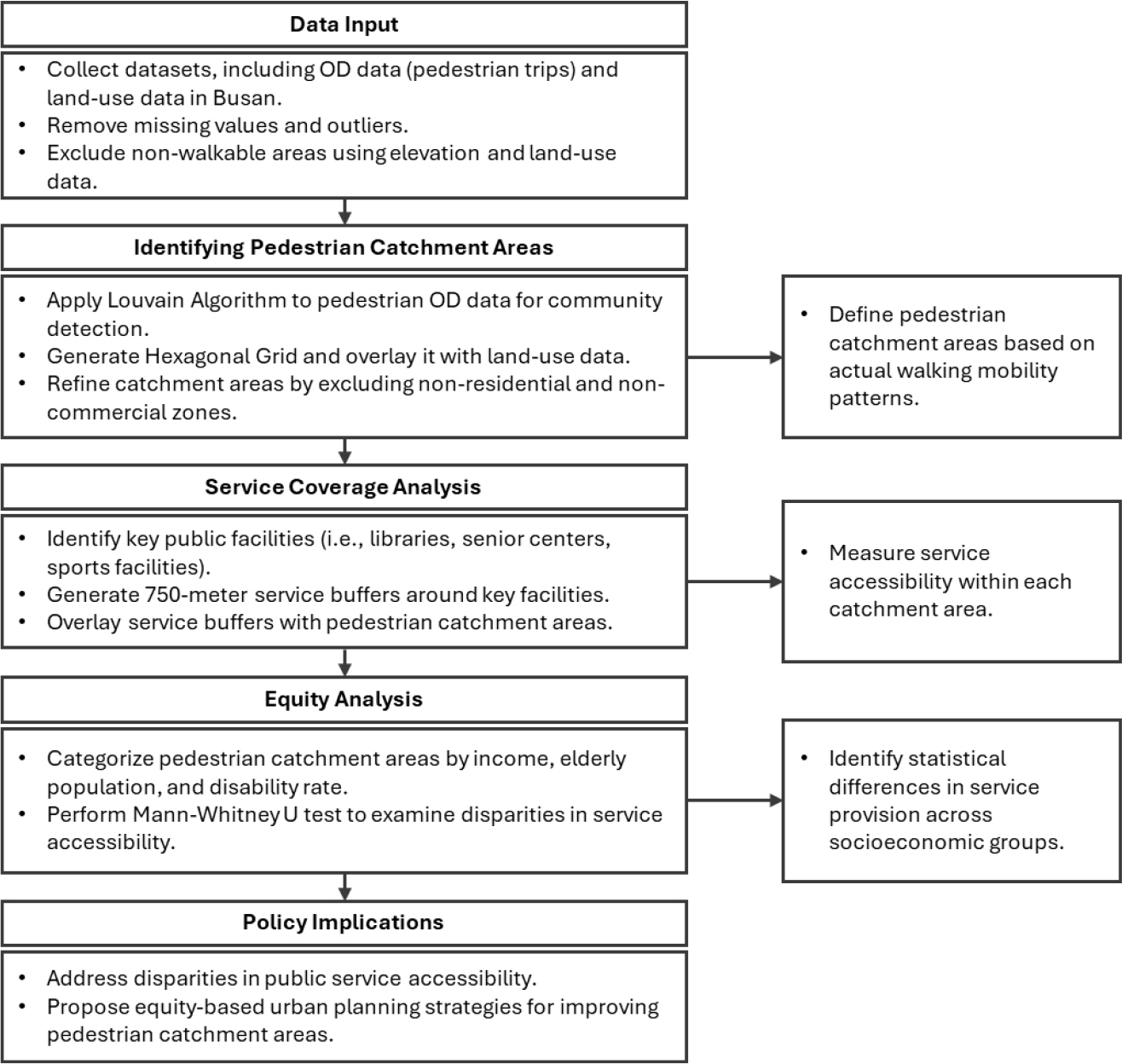
-
Network-Based Identification of Pedestrian Catchment Areas and Assessment of Public Service Accessibility and Equity: Focusing on Anchor Facilities in Busan Metropolitan City
-
Article
-
Studying the Impact of Consumer Income Characteristics on Zero-Emission Car Adoption: Bottom-up Road Transport Model Approach
소비자 소득 특성이 친환경 차량 보급에 미치는 영향 연구: 상향식 도로 수송 모형을 통한 접근
-
KIM, Ayeong, YEO, Yeongjun, AHN, Young Hwan
김아영, 여영준, 안영환
- The transport sector plays a dual role—it's essential for economic activity and human well-being, but it is also a major source of …
수송 부문은 경제 활동과 인간 복지에 중요한 역할을 함과 동시에 온실가스 배출의 주요 원인으로 꼽히고 있다. 특히 도로 교통에서는 친환경 차량의 보급이 …
- The transport sector plays a dual role—it's essential for economic activity and human well-being, but it is also a major source of greenhouse gas emissions. While electric vehicles are promoted as a key solution for reducing emissions in road transport, their higher upfront costs pose challenges, particularly for lower-income households who face higher implicit discount rates in their purchasing decisions. This study enhances existing bottom-up linear programming transport models by incorporating consumer income characteristics into the analysis of passenger car choices from 2019 to 2050. The study divided driving distances into eight categories based on household income levels and applied income-specific implicit discount rates. It also factored in how gross domestic product growth affects household income levels over time—an aspect previously overlooked. The model results reveal significant differences in electric vehicle adoption patterns across income groups. When income characteristics and varying discount rates are considered, low-income households show lower electric vehicle adoption rates compared to previous model predictions, while high-income households exhibit higher adoption rates. These disparities become even more pronounced under carbon tax policy scenarios. The study concludes that for transport sector carbon neutrality policies to be effective, they must account for various factors influencing vehicle purchase decisions, especially income-related constraints. It specifically recommends developing differentiated subsidy policies for different income groups to promote more equitable adoption of electric vehicles across all economic segments of society.
- COLLAPSE
수송 부문은 경제 활동과 인간 복지에 중요한 역할을 함과 동시에 온실가스 배출의 주요 원인으로 꼽히고 있다. 특히 도로 교통에서는 친환경 차량의 보급이 주요 감축 정책으로 활용되고 있다. 그러나 현재 친환경 차의 보급 수준이 이전에 비해 많이 둔화하여 재활성화를 위한 조치가 필요한 시점이다. 에너지 효율이 높은 친환경 차량은 기존의 내연기관차에 비해 고가인 경우가 많지만, 운행 중 에너지를 절약해 에너지 비용을 절감함으로써 궁극적으로 비용 효율성을 달성할 수 있다. 그러나 실제 소비자의 에너지 효율 투자 결정에서 소득 수준이 낮은 가구일수록 높은 내재적 할인율이 작용하여 구매로 이어지지 않는다는 경험적 연구가 다수 이루어졌다. 온실가스 배출 경로의 비용, 잠재력, 결과 등을 평가하고 정책을 수립하는 데 에너지시스템 모형이 유용하게 사용되나, 그중 상향식 모형은 대표 소비자를 상정하기 때문에, 이러한 소비자 특성에 따른 차이를 현실적으로 반영하지 못한다는 한계가 지적된다. 본 연구는 이를 개선하기 위해 기존 상향식 도로 수송 모형에 소득 수준별로 8개 구간을 설정하여 주행거리와 내재적 할인율을 차등 적용하고, 국내총생산 증가가 가구 소득에 미치는 영향을 반영했다. 모형 분석 결과, 소득이 낮은 가구에서는 할인율 세분화 및 소득 증가 반영 이전보다 전기차 보급이 감소한 반면, 소득이 높은 가구에서는 증가한 것으로 나타났다. 또한, 탄소세 적용 시나리오에서는 이러한 차이가 더욱 뚜렷하게 나타났다. 이를 통해, 정부의 수송 부문 탄소중립 목표 달성을 위한 정책 수립 시, 소비자의 차량 구매 결정에 영향을 미치는 다양한 요소를 고려할 필요가 있음을 확인했다. 특히, 보조금 정책을 소득 구간별로 차등 적용하는 방안을 통해 친환경 차량 보급을 다시 확대할 수 있는 가능성을 제시하였다.
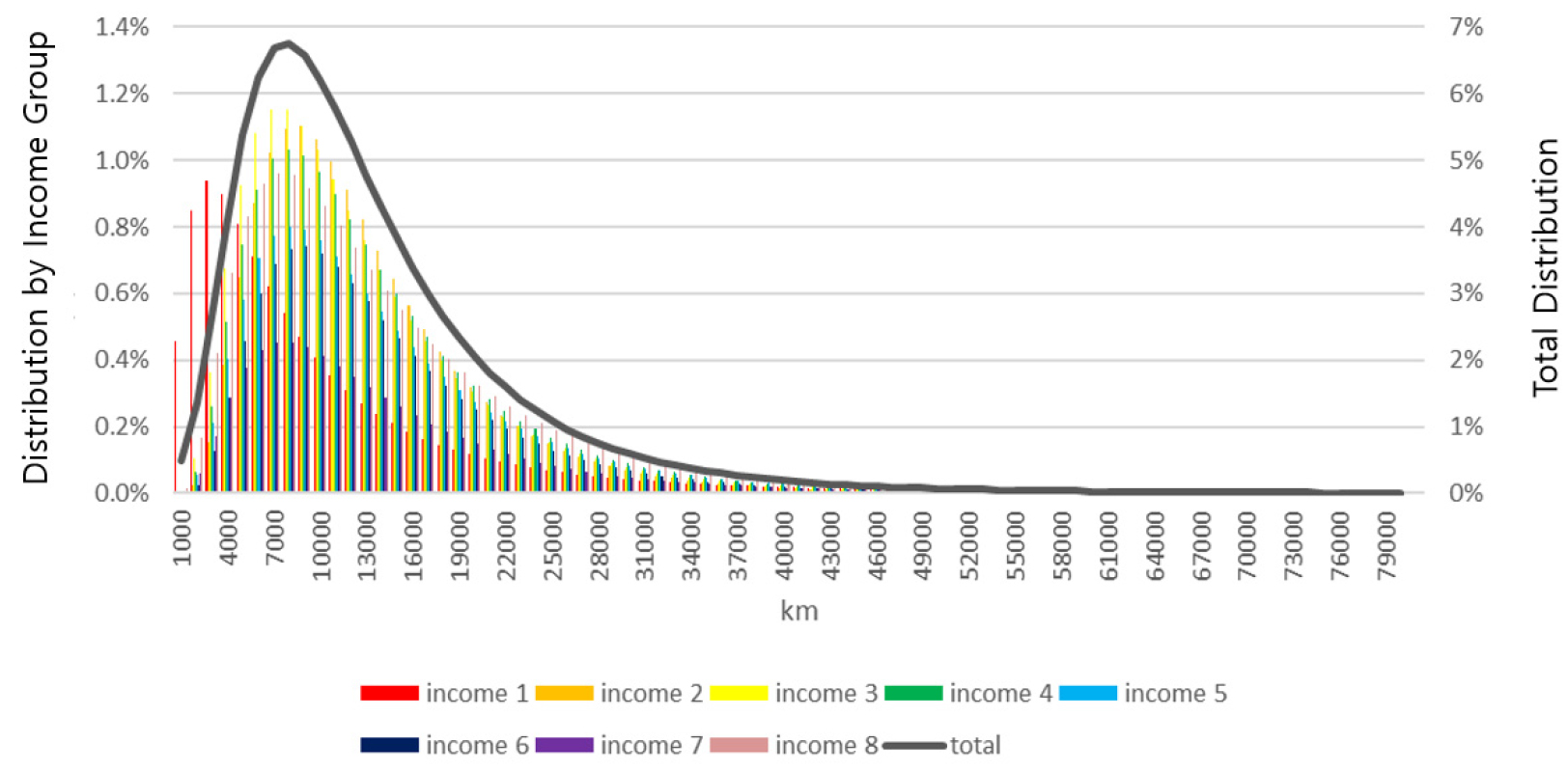
-
Studying the Impact of Consumer Income Characteristics on Zero-Emission Car Adoption: Bottom-up Road Transport Model Approach
-
Article
-
Classification of Urban Rail Transfer Stations by Analysis of Traver Behavior and Multidimensional Local Characteristics
통행행태와 다차원 지역 특성 분석을 통한 도시철도 환승역 유형화 연구
-
KIM, Taejun, JU, Yunho, KIM, Junghwa
김태준, 주윤호, 김정화
- This study aims to classify 67 urban rail transfer stations in Seoul by comprehensively analyzing user travel behavior and multidimensional local characteristics …
본 연구는 서울특별시 도시철도 환승역 67개소를 대상으로 이용자 통행행태와 철도역 인근 다차원 지역 특성을 종합적으로 분석하여 환승역 유형 분류를 수행하고, 도출된 유형을 …
- This study aims to classify 67 urban rail transfer stations in Seoul by comprehensively analyzing user travel behavior and multidimensional local characteristics surrounding each station. Utilizing smart card data, key indicators such as number of getting on/off passenger, time-based getting on/off ratios, transfer volumes, and wide area trip volumes were derived to represent travel behavior. Simultaneously, variables for clustering were constructed by integrating multidimensional spatial characteristics of areas around the stations, including public distance accessibility, population and employment density, and land use diversity. PCA was conducted to extract major components from the variables, followed by the application of a hybrid clustering method combining hierarchical and K-means clustering to classify the transfer stations into five distinct types. Based on the characteristics of user travel behavior and local features within each cluster, the resulting station types were defined as: Mixed Type, Business Type, Suburban Transfer Hub Type, Residential Type, and Central Hub Type. Statistically significant differences among clusters were confirmed through ANOVA and interpretation of principal components to validate the classification. Furthermore, this study proposes practical applications of the identified types in areas such as congestion and demand management, transfer facility improvement, and Transit-Oriented Development strategies. The results are expected to serve as foundational data for the integrated management and operation of urban rail transfer stations and for policy formulation.
- COLLAPSE
본 연구는 서울특별시 도시철도 환승역 67개소를 대상으로 이용자 통행행태와 철도역 인근 다차원 지역 특성을 종합적으로 분석하여 환승역 유형 분류를 수행하고, 도출된 유형을 바탕으로 정책적인 활용 방안을 제시하였다. 먼저, 교통카드 데이터를 기반으로 승하차인원, 시간대별 승·하차 비율, 환승통행량, 광역통행량 등 이용자 통행행태를 도출하고, 대중교통 접근성, 인구 및 종사자수 밀도, 토지이용 다양성 등 철도역 인근 지역의 다차원 공간적 특성을 통합하여 유형 분석을 위한 변수를 구축하였다. 이후 PCA을 통해 변수들의 주요 요인을 도출하고, 계층적 클러스터링과 K-means 클러스터링을 결합한 혼합 클러스터링 기법을 적용하여 다섯가지 유형으로 분류했다. 도출된 유형을 실제 군집에 포함된 역사들의 이용자 통행행태와 지역 특성 데이터 성격에 따라 혼합형, 업무형, 외곽 환승허브형, 주거형, 중심지 허브형의 정의하였다. 각 유형은 통행행태, 다차원 지역 특성 지표에서 유의미한 차이를 확인하였으며, 군집 간 차이를 확인하기 위한 분산분석, 주성분을 통한 유형 해석을 통해 분류의 타당성을 확보하려고 노력했다. 아울러, 본 연구에 따라 도출된 유형을 혼잡도 및 수요 관리, 환승시설 개선, TOD 개발 전략 등에 활용하는 방안을 제시했다. 이를 통해 도시철도 환승역의 통합적 관리 및 운영 체계 구축과 정책 수립에 기초자료로 활용될 수 있을 것으로 기대된다.

-
Classification of Urban Rail Transfer Stations by Analysis of Traver Behavior and Multidimensional Local Characteristics
-
Article
-
Optimal Fare Setting for Congestion Mitigation and Revenue Maximization in the Seoul Subway Line 2 Using the Non-dominated Sorting Genetic Algorithm II
NSGA-II를 활용한 서울시 지하철 2호선 혼잡 완화와 수익 증대를 위한 최적 요금 산정
-
YOON, Sungjin, LEE, Jooyong
윤성진, 이주용
- The Seoul Subway is currently experiencing increased social costs and financial deficits due to severe congestion and an inefficient fare structure. In …
서울시 지하철은 높은 혼잡도와 요금 체계의 비효율성으로 인해 사회적 비용 증가와 재정 적자가 발생하고 있다. 이를 해결하기 위해 본 연구에서는 NSGA-II (Non-dominated …
- The Seoul Subway is currently experiencing increased social costs and financial deficits due to severe congestion and an inefficient fare structure. In response, this study applies the Non-Dominated Sorting Genetic Algorithm II to determine optimal time-based fares for Seoul Subway Line 2. Non-Dominated Sorting Genetic Algorithm II is a multi-objective optimization technique capable of handling conflicting objectives simultaneously; here, it is used in conjunction with congestion data and fare elasticity to analyze how a variable fare system influences demand. The results show that introducing time-based variable fares can effectively redistribute passengers from congested to less congested periods, while also improving profitability compared to the existing fare system. Moreover, by examining the Pareto front, this study identifies several optimal solutions for the two competing objectives and conducts a detailed comparison of representative solutions that achieve a balance between congestion mitigation and revenue enhancement. These findings enable the proposal of concrete fare strategies that can be adopted when implementing a variable fare system. The significance of this research lies in demonstrating that a time-based variable fare strategy can simultaneously alleviate congestion and enhance financial stability, and it suggests the potential for expansion to other lines or different modes of transportation in the future.
- COLLAPSE
서울시 지하철은 높은 혼잡도와 요금 체계의 비효율성으로 인해 사회적 비용 증가와 재정 적자가 발생하고 있다. 이를 해결하기 위해 본 연구에서는 NSGA-II (Non-dominated Sorting Genetic Algorithm-II)를 활용하여 서울시 지하철 2호선의 시간대별 최적 요금을 산정하였다. NSGA-II는 서로 상충하는 목표를 동시에 고려할 수 있는 다목적 최적화 기법으로, 본 연구에서는 혼잡도 자료와 요금 탄력성 등을 연계하여 차등 요금에 따른 수요 변화를 분석하였다. 그 결과, 차등 요금제를 통해 혼잡한 시간대의 이용객을 비혼잡 시간대로 효과적으로 분산시키는 동시에 기존 요금체계 대비 수익성이 향상되었음을 확인하였다. 또한, 파레토 프런트를 통해 상충하는 두 목표 간의 여러 최적 해를 도출하였으며, 그 중 각 목적을 대표하는 최적 해가 제시하는 혼잡 완화와 수익 증가 간의 균형점을 구체적으로 비교하였다. 이를 통해 차등 요금제 도입 시 적용 가능한 구체적인 요금 설계안을 도출할 수 있다. 본 연구에서는 시간대별 차등 요금제를 도입함으로써 혼잡 완화와 재정적 안정성을 동시에 도모할 수 있음을 보인 점에서 의의가 있으며, 이는 향후 다른 노선 혹은 교통수단으로의 확장 적용 가능성도 시사한다.
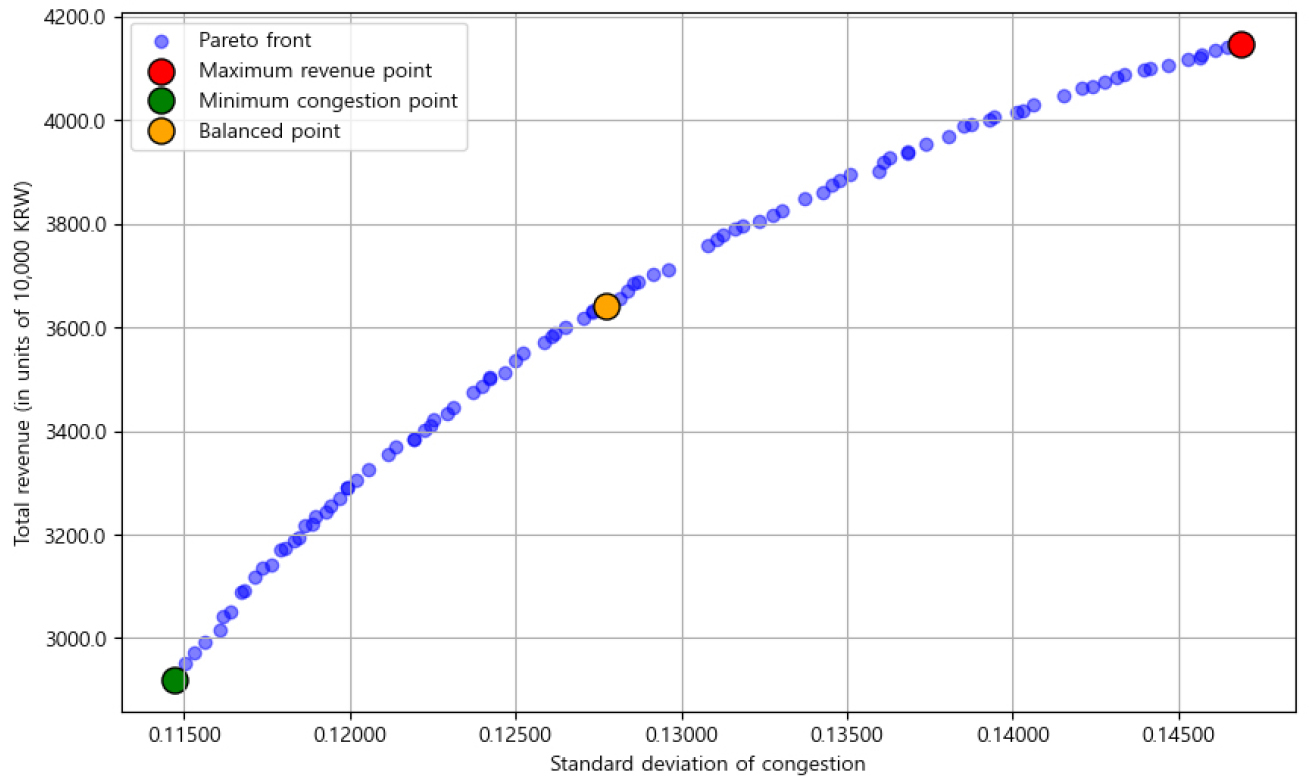
-
Optimal Fare Setting for Congestion Mitigation and Revenue Maximization in the Seoul Subway Line 2 Using the Non-dominated Sorting Genetic Algorithm II
-
Article
-
Evaluation of Transfer Efficiency Considering Intermodal Connectivity: Focusing on Urban Metro Transfer Stations in Seoul
대중교통 수단 간 연계 환승을 고려한 도시철도 역사 환승 효율성 평가: 서울시 내 환승역을 중심으로
-
HAN, Eun-Seo, PARK, Ho-Chul
한은서, 박호철
- As public transportation use grows in the Seoul metropolitan area, the transfer system has become more complex, increasing time, costs, and user …
수도권 대중교통 이용객이 꾸준히 증가하면서 환승 시스템이 점차 복잡해지고, 불필요한 시간과 비용 소모와 환승 과정에서의 불편이 심화되고 있다. 특히 복잡한 환승 동선과 …
- As public transportation use grows in the Seoul metropolitan area, the transfer system has become more complex, increasing time, costs, and user discomfort due to inefficient routes and poor facility connectivity. In response, this study aims to evaluate the efficiency of subway transfer stations in the Seoul metropolitan area, considering intermodal connectivity, and propose improvement measures. Using smart card data, we derived transfer flows and average transfer times, and constructed a dataset of 105 transfer stations, including key variables representing the characteristics of each station. Data Envelopment Analysis (DEA) was employed to analyze the efficiency of transfer stations and revealed that some were efficient, but most showed inefficiencies. Key factors negatively affecting efficiency include station depth, escalator count, bus routes, and congestion. Additionally, stations were grouped through k-means++ clustering, and the characteristics and efficiency levels of each group were identified. Based on the characteristics of each group, the structural differences in efficiency were analyzed, and differentiated improvement directions were proposed. Through this, it was confirmed that improving the transfer environment is not merely a matter of resource allocation but requires an approach that considers user behavior. The results are expected to serve as an important basis for improving the efficiency of transit station operations and designing public transportation policies.
- COLLAPSE
수도권 대중교통 이용객이 꾸준히 증가하면서 환승 시스템이 점차 복잡해지고, 불필요한 시간과 비용 소모와 환승 과정에서의 불편이 심화되고 있다. 특히 복잡한 환승 동선과 부족한 시설 연계성은 효율성을 저해하는 주요 요인으로 작용하며, 대중교통 수단 간 연계 환승이 원활하지 않아 이용자 부담이 가중되고 있는 상황이다. 이에 본 연구에서는 수단 간 연계 환승을 고려하여 수도권 지하철 환승역의 효율성을 평가하고 개선 방안을 마련하고자 하였다. 효율성은 환승역의 여러 인프라 요소가 수단 간 연계 환승 과정에서 얼마나 효과적으로 활용되는지를 평가하는 지표로 정의하였다. 스마트카드 데이터를 활용해 환승 통행량과 평균 환승시간을 도출하고 역의 특성을 보일 수 있는 주요 변수를 포함한 105개 환승역의 데이터셋을 구축하였다. 자료포락분석을 활용해 환승역의 효율성을 분석한 결과, 일부 환승역은 자원 투입 대비 높은 효율성을 보였으나, 다수의 환승역에서 비효율성이 확인되었다. 효율성에 영향을 미치는 주요 요인을 도출한 결과, 역의 심도, 에스컬레이터 수, 평균 버스 노선 수, 혼잡도가 효율성을 저해하는 변수로 나타났다. 추가적으로 k-means++군집화를 통해 환승역을 그룹화하고, 그룹별 특성과 효율성 수준을 파악하였다. 각 그룹의 특성에 기반하여 효율성의 구조적 차이를 분석하고, 차별화된 개선 방향을 제시하였으며, 이를 통해 환승 환경 개선이 단순한 자원 배치 문제가 아닌 이용자 행태를 고려한 접근이 필요함을 확인하였다. 이 결과는 환승역 운영 효율성 향상과 대중교통 정책 설계에 중요한 기초 자료로 활용될 것으로 기대된다.
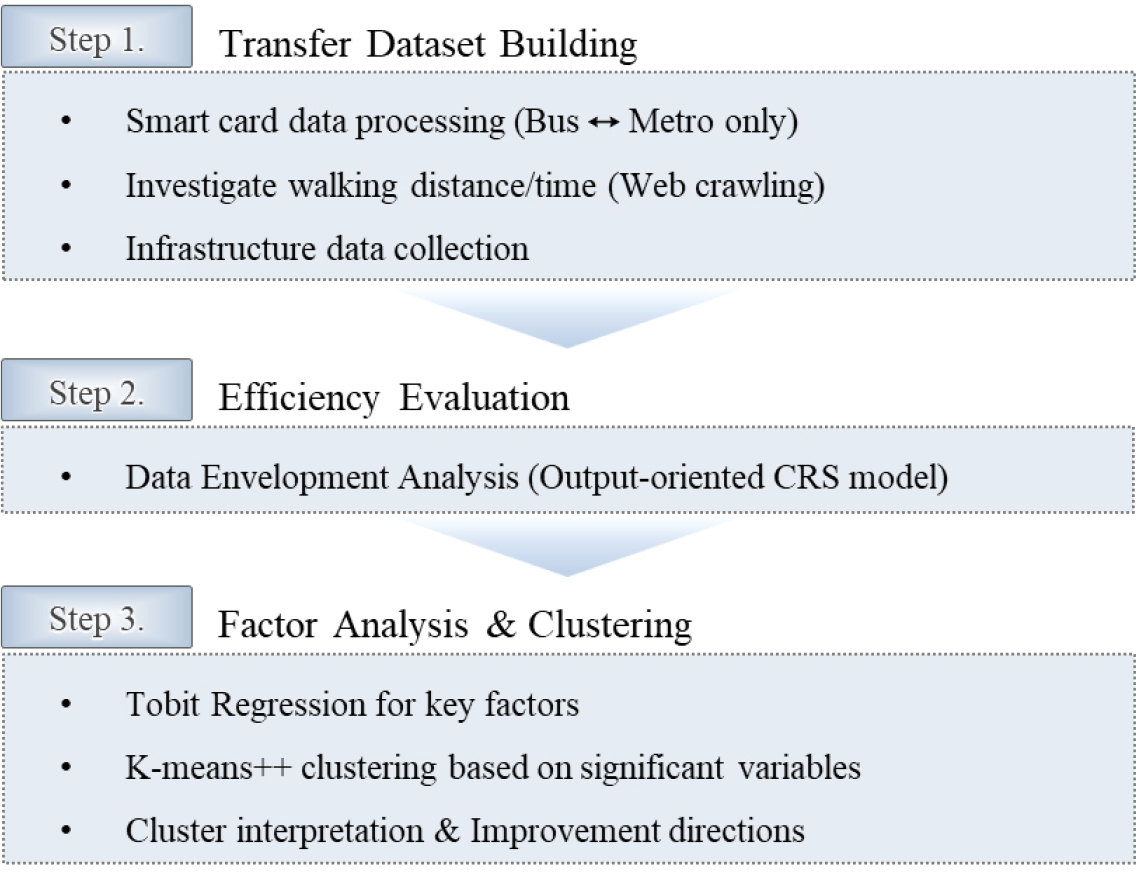
-
Evaluation of Transfer Efficiency Considering Intermodal Connectivity: Focusing on Urban Metro Transfer Stations in Seoul
Journal Informaiton
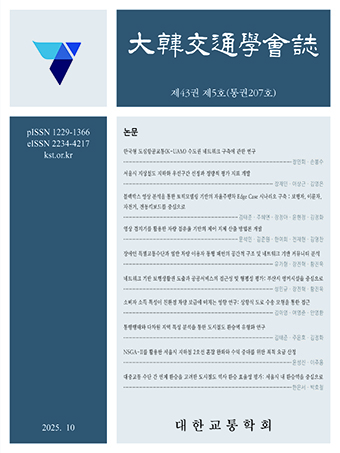 Journal of Korean Society of Transportation
Journal of Korean Society of Transportation
Journal Informaiton
Journal Informaiton - close
 Journal of Korean Society of Transportation
Journal of Korean Society of Transportation



